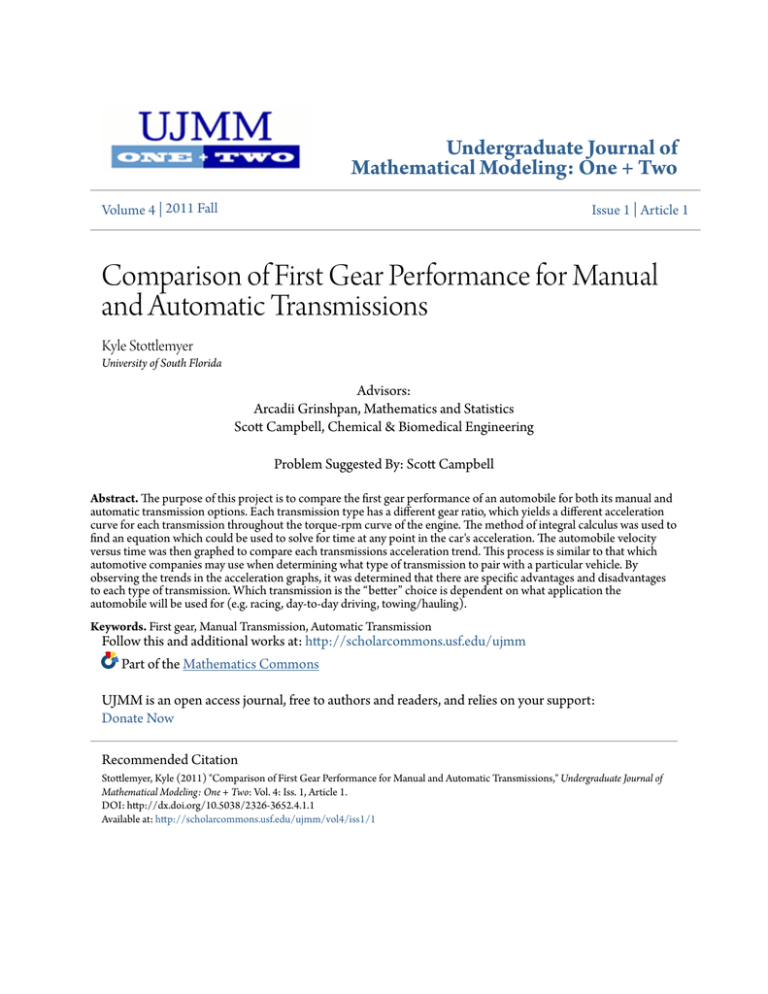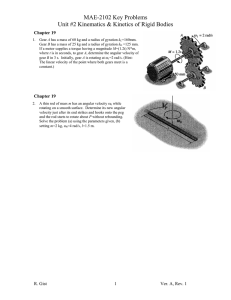Comparison of First Gear Performance for Manual and Automatic
advertisement

Undergraduate Journal of Mathematical Modeling: One + Two Volume 4 | 2011 Fall Issue 1 | Article 1 Comparison of First Gear Performance for Manual and Automatic Transmissions Kyle Stottlemyer University of South Florida Advisors: Arcadii Grinshpan, Mathematics and Statistics Scott Campbell, Chemical & Biomedical Engineering Problem Suggested By: Scott Campbell Abstract. The purpose of this project is to compare the first gear performance of an automobile for both its manual and automatic transmission options. Each transmission type has a different gear ratio, which yields a different acceleration curve for each transmission throughout the torque-rpm curve of the engine. The method of integral calculus was used to find an equation which could be used to solve for time at any point in the car's acceleration. The automobile velocity versus time was then graphed to compare each transmissions acceleration trend. This process is similar to that which automotive companies may use when determining what type of transmission to pair with a particular vehicle. By observing the trends in the acceleration graphs, it was determined that there are specific advantages and disadvantages to each type of transmission. Which transmission is the “better” choice is dependent on what application the automobile will be used for (e.g. racing, day-to-day driving, towing/hauling). Keywords. First gear, Manual Transmission, Automatic Transmission Follow this and additional works at: http://scholarcommons.usf.edu/ujmm Part of the Mathematics Commons UJMM is an open access journal, free to authors and readers, and relies on your support: Donate Now Recommended Citation Stottlemyer, Kyle (2011) "Comparison of First Gear Performance for Manual and Automatic Transmissions," Undergraduate Journal of Mathematical Modeling: One + Two: Vol. 4: Iss. 1, Article 1. DOI: http://dx.doi.org/10.5038/2326-3652.4.1.1 Available at: http://scholarcommons.usf.edu/ujmm/vol4/iss1/1 Stottlemyer: Comparison of First Gear Performance for Manual and Automatic Tra 2 KYLE STOTTLEMYER TABLE OF CONTENTS Problem Statement .............................................................................................................. 3 Motivation ........................................................................................................................... 3 Mathematical Description and Solution Approach ............................................................. 4 Discussion ........................................................................................................................... 7 Conclusion and Recommendations ..................................................................................... 8 Nomenclature ...................................................................................................................... 9 References ........................................................................................................................... 9 Produced by The Berkeley Electronic Press, 2011 Undergraduate Journal of Mathematical Modeling: One + Two, Vol. 4, Iss. 1 [2011], Art. 1 COMPARISON OF FIRST GEAR PERFORMANCE 3 PROBLEM STATEMENT A car comes with a choice of manual or automatic transmission. The car’s mass is , the radius of the tires is redlines at and , it idles at . The gear ratios (for first gear) are for the manual transmission. The final drive ratio is (revolutions per minute), and for the automatic transmission . This project investigates and describes the advantages and disadvantages of each transmission type for first gear performance. By graphing the car’s speed (in ) versus time (in ) for each transmission, the acceleration slope for each transmission type will be analyzed and compared. At the car is coasting at idle, and results will be provided up to the time the engine reaches redline. MOTIVATION This type of problem is important to automotive manufacturers, racing development firms, and even research and development teams. The data gained from such a problem is very important to mechanical engineers trying to optimize vehicle designs. Each type of transmission has certain benefits depending on what the engineer is trying to achieve with the car. For example, one company may want better fuel economy while the other might want better acceleration or top speed. The purpose of this project is to determine what possible advantages and disadvantages each transmission has to offer, and how to better optimize designs in the future. This project focuses, specifically, on first gear performance. http://scholarcommons.usf.edu/ujmm/vol4/iss1/1 DOI: http://dx.doi.org/10.5038/2326-3652.4.1.1 Stottlemyer: Comparison of First Gear Performance for Manual and Automatic Tra 4 KYLE STOTTLEMYER MATHEMATICAL DESCRIPTION AND SOLUTION APPROACH In order to get car velocity versus time graph, two functions are required. The first is a function of velocity with respect to (engine speed in radians/second converted from the given RPM values). The second is a function of time with respect to (velocity) and (engine torque). Equations (1) through (7), described below, govern the forces of the system. The relation between car speed and the angular velocity of the wheel is: . (1) and torque at the wheel The relationship between acceleration is: . Relations between the engine speed (2) , driveshaft speed and wheel speed are given by: , (3) . (4) Assuming no losses between the engine and wheels, the engine relations between torque driveshaft torque , and wheel torque , : . (5) Combining these equations provides relationships for the velocity and acceleration of the car as a function of engine speed and engine torque: , (6) and . Equating the derivative of equation (6) with respect to Produced by The Berkeley Electronic Press, 2011 (7) in terms of with equation (7) yields Undergraduate Journal of Mathematical Modeling: One + Two, Vol. 4, Iss. 1 [2011], Art. 1 COMPARISON OF FIRST GEAR PERFORMANCE 5 . which may be simplified and integrated using the given boundary conditions for the limits: ∫ ∫ . (8) The left side of the equation (8) may be estimated numerically using the trapezoidal rule (Kaw 2009): ∫ ∑ [( which can be easily calculated from the observed values of ( )( )] ) ( (9) ) for each transmission. With the approximation from (9), equation (8) may be rearranged to solve for : (10) Using equations (6) and equation (10), the velocity of the car and its associated point in time can now be determined. Calculated times for each gear appear in Table 1 and graphed in Chart 1. The car’s acceleration can be found by observing the change in velocity over time. http://scholarcommons.usf.edu/ujmm/vol4/iss1/1 DOI: http://dx.doi.org/10.5038/2326-3652.4.1.1 Stottlemyer: Comparison of First Gear Performance for Manual and Automatic Tra 6 KYLE STOTTLEMYER 20 Velocity (meters/second) 18 16 14 12 10 8 6 Manual 4 Automatic 2 0 0 0.2 0.4 0.6 Time (seconds) 0.8 1 1.2 Chart 1: Graph of velocity at calculated times for the manual and automatic gears. RPM (auto) (auto) (manual) (manual) 600 134 0.00 1.86 0.00 1.26 1000 228 0.26 3.09 0.12 2.11 1500 400 0.45 4.64 0.21 3.16 2000 536 0.57 6.19 0.26 4.21 2500 630 0.66 7.74 0.31 5.27 3750 751 0.86 11.60 0.40 7.90 4250 771 0.94 13.15 0.43 8.95 4450 751 0.96 13.77 0.45 9.38 5250 671 1.09 16.24 0.50 11.06 6000 550 1.22 18.57 0.57 12.64 Table 1: Recorded values of RPMs, torque, and velocity for the manual and automatic gears. Produced by The Berkeley Electronic Press, 2011 Undergraduate Journal of Mathematical Modeling: One + Two, Vol. 4, Iss. 1 [2011], Art. 1 COMPARISON OF FIRST GEAR PERFORMANCE 7 DISCUSSION It was determined from the resulting velocity versus time graph (Chart 1) that the manual transmission provides a higher rate of acceleration through first gear but a lower top speed at the engine’s redline than the automatic transmission. This information provides useful data trends which can be used to fulfill the original objective of the project: determining the advantages and disadvantages of one type of transmission over the other. Manual transmissions are generally accepted to provide faster accelerations than their automatic counterparts, which is why they are often available in sports cars (although better acceleration does not necessarily mean it is the better transmission). Automatic transmissions often have less total gears than their manual counterparts, which mean each gear must have a higher top speed if the vehicle is going to achieve a similar top speed with either transmission offering. The results shown by the Chart 1 are reasonable and in line with expectations for these reasons. These results have many potential implications for both this problem specifically, and to the field of mechanical engineering in general. For this problem, specifically, these results will help determine which transmission is chosen for the car. For the field of mechanical engineering, these results could have a much broader impact. The methods used in this project can be applied to any two transmissions, and can be an effective tool for mechanical engineers throughout the field to model and test transmission designs for various applications. Analyze transmission performance using this method is much cheaper and faster than analyze by producing prototype transmissions and using a dynamometer (a device which can analyze torque, power and RPM) to assess them. Although mathematical modeling can not necessarily replace the final prototyping and testing of a transmission, it can help save time and money in the research and development http://scholarcommons.usf.edu/ujmm/vol4/iss1/1 DOI: http://dx.doi.org/10.5038/2326-3652.4.1.1 Stottlemyer: Comparison of First Gear Performance for Manual and Automatic Tra 8 KYLE STOTTLEMYER phase. This could lead to better transmissions since the design process would now be more efficient and cost effective. CONCLUSION AND RECOMMENDATIONS The objective of this project was to compare the advantages and disadvantages between manual and auto transmission. Whether the acceleration characteristics of each transmission are an advantage or a disadvantage is not as clear cut as might be expected. For example, if acceleration is the most important factor for the car, then an engineer might deem the manual to be the better choice. Alternatively, it may be more desirable and more practical for the average car to have a higher top speed in each gear. A higher top speed in each gear (if this trend is consistent throughout all gears of each transmission) would also mean less shifting between gears which could be more comfortable and more convenient for the average driver. Each transmission would be particularly well-suited for a certain application, but neither would be considered best for all applications (Naunheimer 2010). Since this project only covers first gear performance, the entire transmission assemblies are not being fully compared. We would recommend that future projects analyze all of the gears of each transmission method. This would provide a more complete analysis of the advantages/disadvantages of each transmission type. Produced by The Berkeley Electronic Press, 2011 Undergraduate Journal of Mathematical Modeling: One + Two, Vol. 4, Iss. 1 [2011], Art. 1 COMPARISON OF FIRST GEAR PERFORMANCE 9 NOMENCLATURE Symbol Description Units Tire Radius Angular Velocity of the Engine Angular Velocity of the Wheel Angular Velocity of the Driveshaft Gear Ratio Final Drive Ratio Engine Torque Wheel Torque Driveshaft Torque Mass Time Velocity Initial Velocity REFERENCES Kaw, Autar K. and Kalu, E. Eric. Numerical Methods with Applications. Morrisville, NC: Lulu Enterprises, 2009. Print. Naunheimer, Harald. Automotive Transmissions Fundamentals, Selection, Design and Application. Berlin: Springer, 2010. Print. http://scholarcommons.usf.edu/ujmm/vol4/iss1/1 DOI: http://dx.doi.org/10.5038/2326-3652.4.1.1


